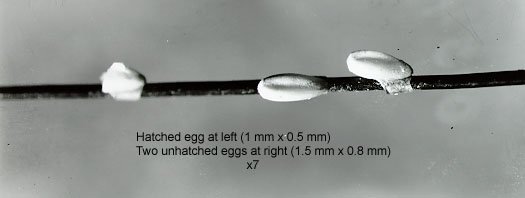MPM: V-12. Cosmetic Products
A. Method for Cosmetic Brushes (V-119)
(1) Scope
This method provides a procedure for the visual examination of cosmetic brushes containing hog bristles which may be contaminated with eggs (nits) of the hog louse (Haematopinus suis).
(2) Applicable Documents
(3) Defects
Hog bristles incorporated into cosmetic brushes may contain eggs (nits) of the hog louse. The hog louse is found on hogs throughout the world and passes its entire life cycle on the body of the hog. The eggs may be attached to the hairs or bristles on any part of the hog's body. They are individually glued to the hairs by means of an encircling band (Figure V-11). As many as six eggs may be glued to a single hair.
Figure V-11
EGGS (NITS) OF THE HOG LOUSE ON HOG BRISTLES
(4) Wharf Examination
Generally, the sample has come into the laboratory based on the results of a wharf examination. On the wharf, at least six brushes from each lot are examined. Samples are collected for laboratory examination if
- Nits are observed on bristles of two or more brushes
- Nits are observed on ten or more bristles on any brush of the six examined
(5) Procedure: Determination of Nit-Contaminated Bristles in Cosmetic Brushes
- Visual Examination and Classification of Reject Bristles -- Examine at least six brushes. Determine the number of bristles contained in a representative number of tufts and calculate the total number of bristles in the brush. Count the number of bristles contaminated with nits and nit fragments in the entire brush. A nit-contaminated bristle is one which has one or more hatched or unhatched nits attached, or one which bears fragments of the hatched egg (Figure V-11). If the contamination is heavy, count the contaminated bristles in a representative portion of the brush and calculate the total number of bristles with nits. These observations may be confirmed by the use of a 7-10X hand lens.
- Report -- For each brush examined, report the number of nit-contaminated bristles, the total number of bristles in the brush, and the percentage of contaminated bristles. Also calculate and report the average percentage of contaminated bristles for all brushes examined in each sample.


